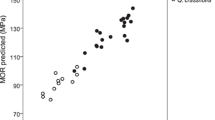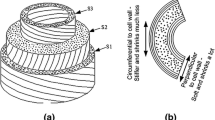Abstract
This paper deals with the ability of a scientific strategy to compute the shrinkage behaviour of any oak sample, regardless of its origin, density, growth ring, etc. This approach uses the description of the actual oak structure at the annual ring level (i.e. the spatial organisation of the radial ray-cells, fibre, parenchyma areas and large vessels), to evaluate its shrinkage/swelling and elastic properties in the transverse directions. For the shrinkage properties, computed results were compared with experimental values measured on a set of samples depicting a very large diversity of anatomical patterns. The accuracy of our prediction is about 5% in the tangential direction and 20% in the radial direction, which is much better than statistical models over a wide range of variables. These results are discussed and a few microscopic observations with ESEM allow explanation of anomaly points of behaviour to be formulated. Such good results could allow this approach to be used to study the influence of growing conditions or of global changes upon physical wood properties.









Similar content being viewed by others
References
Badel E (1999) Détermination des propriétés élastiques et du retrait d’un cerne annuel de chêne dans le plan transverse: description de la morphologie, mesures des propriétés microscopiques et calculs d’homogénéisation. PhD dissertation, ENGREF, Nancy
Badel E, Bakour R, Perré P (2006) Investigation of the relationship between anatomical pattern, density and local swelling of oak wood. IAWA 271:55–71
Badel E, Perré P (1999) Détermination des propriétés élastiques d’éléments individuels du plan ligneux du chêne par des essais de traction sur micro-éprouvettes. Ann Forest Sci 56:467–478
Badel E, Perré P (2001) Using a digital X-ray imaging device to measure the swelling coefficients of a group of wood cells. NDT&E 34:345–353
Badel E, Perré P (2002) Predicting oak wood properties using X-ray inspection: representation, homogenisation and localisation. Part I: Digital X-ray imaging and representation by finite elements. Ann Forest Sci 59:767–776
Bakour R (2003) Influence de l’espèce et de la provenance des deux principaux chênes français (Quercus Robur L.; Quercus Petrea Liebl.) sur la structure anatomique et les propriétés du bois de merrain. PhD dissertation, ENGREF, Nancy
Barber NF (1968) A theoritical model of shrinking wood. Holzforschung 22:97–103
Beismann H, Schweingruber F, Speck T, Korner C (2002) Mechanical properties of spruce and beech wood grown in elevated CO2. Trees -- Struct Funct 168:511–518
Berges L, Dupouey J-L, Franc A (2000) Long-term changes in wood density and radial growth of Quercus petraea Liebl. in northern France since the middle of the nineteenth century. Trees -- Struct Funct 147:398–408
Burgert I, Bernasconi A, Niklas KJ, Eckstein (2001) The influence of rays on the transverse elastic anisotropy in green wood of deciduous trees. Holzforschung 55:449–454
Clair B, Ruelle J, Thibaut B (2003) Relationship between growth stress, mechanical-physical properties and proportion of fibre with gelatinous layer in chestnut (castanea sativa mill.). Holzforschung 572:189–195
El Amri F (1987) Contribution à la modélisation élastique anisotrope du matériau bois-feuillus et résineux. PhD dissertation, I.N.P.L., Nancy
Eyono Owoundi R (1992) Modélisation de la rétractibilite du bois en relation avec des paramètres de la structure de l’accroissement annuel et de la position dans l’arbre chez Quercus robur et Q. petraea. PhD dissertation, ENGREF, Nancy
Farruggia F (1998) Détermination du comportement élastique d’un ensemble de fibres de bois à partir de son organisation cellulaire et d’essais mécaniques sous microscope. PhD dissertation, ENGREF, Nancy
Gu H, Zink-Sharp A, Sell J (2001) Hypothesis on the role of cell wall structure in differential transverse shrinkage of wood. Holz als Roh- und Werkstoff 59:436–442
Holmberg S, Persson K, Petersson H (1999) Nonlinear mechanical behaviour and analysis of wood and fibre materials. Comput Struct 724–725:459–480
Kawamura Y (1979) Studies on the properties of rays I. Mokuzai Gakkaishi 25:455–460
Kawamura Y (1984) Studies on the properties of rays II. Mokuzai Gakkaishi 30:201–206
Keller R, Thiercelin F (1975) Influence des gros rayons ligneux sur quelques proprietes du bois de hetre. Ann Forest Sci 32:113–129
Koponen S, Toratti T, Kanerva P (1989) Modelling longitudinal elastic and shrinkage properties of wood. Wood Sci Technol 63:55–63
Le Moguedec G (2000) Modélisation de propriétés de base du bois et de leur variabilité chez le chêne sessile (Quercus petrea Liebl.). Simulation en vue de l’évaluation d’une ressource forestière. PhD dsissertation, ENGREF, Nancy
Pang S (2002) Predicting anisotropic shringkage of softwood. Part 1: theories. Wood Sci Technol 36:75–91
Perré P (2002). Wood as a multi-scale porous medium: observation, experiment, and modelling. In: First international conference of the European Society for wood mechanics (selected and reviewed papers), EPFL, Lausanne, Switzerland, pp 365–384
Perré P (2005) Meshpore: A software able to apply image-based meshing techniques to anisotropic and heterogeneous porous media. Dry Technol 239–11:1993–2006
Perré P, Badel E (2003) Predicting oak wood properties using X-ray inspection: representation, homogenisation and localisation. Part II: Computation of macroscopic properties and microscopic stress fields. Ann Forest Sci 60:247–257
Salmen L (2004) Micromechanical understanding of the cell-wall structure. Comptes Rendus Biologies 3279–10:873–880
Sanchez-Huber J, Sanchez-Palencia E (1992) Introduction aux méthodes asymptotiques et à l’homogénéisation. Masson, Paris
Seco JIF-G, Barra MRD (1996) Growth rate as a predictor of density and mechanical quality of sawn timber from fast growing species. Holz als Roh- und Werkstoff 543:171–174
Washusen R, Ilic J (2001) Relationship between shrinkage and tension wood from three provenances of Eucalyptus globulus Labill. Holz als Roh- und Werkstoff 59:85–93
Watanabe U, Fujita M, Norimoto M (1998) Transverse shrinkage of coniferous wood cells examined using replica method and power spectrum analysis. Holzforshung 52:200–206
Woodcock S (2002) Wood specific gravity and its radial variations: the many ways to make a tree. Trees—Struct Funct 166:437–443
Yamamoto H (1999) A model of the anisotropic swelling and shrinking process of wood. Part 1. Wood Sci Technol 33:311–325
Yamamoto H, Sassus F, Ninomiya M, Gril J (2001) A model of anisotropic swelling and shrinking process of wood; Part 2. A simulation of shrinking wood. Wood Sci Technol 35:167–181
Zhang SY, Nepveu GFM (1994) Modelling intratree wood shrinkage in european oak by measuring wood density. Forest Prod J 4410:42–46
Author information
Authors and Affiliations
Corresponding author
Additional information
Communicated by M. Zwieniecki
Rights and permissions
About this article
Cite this article
Badel, E., Perré, P. The shrinkage of oak predicted from its anatomical pattern: validation of a cognitive model. Trees 21, 111–120 (2007). https://doi.org/10.1007/s00468-006-0105-z
Received:
Revised:
Accepted:
Published:
Issue Date:
DOI: https://doi.org/10.1007/s00468-006-0105-z




